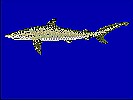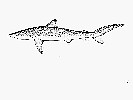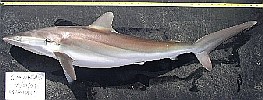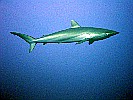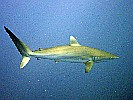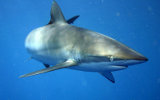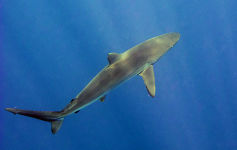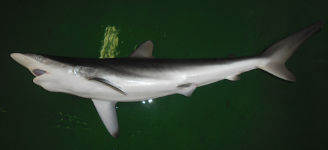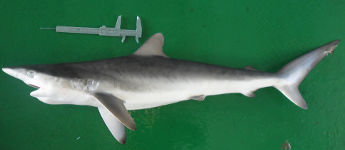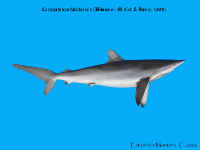Carcharhinus falciformis
(Bibron in Müller & Henle, 1839)
Silky shark
Classification: Elasmobranchii Carcharhiniformes Carcharhinidae
Reference of the original description
Systematische Beschreibung der Plagiostomen. Berlin, Veit, pp. 1–200
Systematische Beschreibung der Plagiostomen. Berlin, Veit, pp. 1–200
Image of the original description
No image in first description.
No image in first description.
Synonyms / new combinations and misspellings
Aprionodon sitankaiensis, Carcharhinus aff. falciformis, Carcharhinus atrodorsus, Carcharhinus cf. falciformis, Carcharhinus falciformes, Carcharhinus floridanus, Carcharhinus malpeloensis, Carcharhinus menisorrah, Carcharias falciformis, Carcharias falcipinnis, Carcharias menisorrah, Carcharias (Prionodon) falciformis, Carcharias (Prionodon) menisorrah, Carcharinus falciformis, Carcharinus floridanus, Carcharinus menisorrah, Carcharius falcipinnis, Eulamia falciformis, Eulamia floridanus, Eulamia malpeloensis, Eulamia menisorrah, Platypodon falciformis, Platypodon menisorrah, Platypodon tiburo, Squalus tiburo., Squalus (Carcharinus) falciformis, Squalus (Carcharinus) menisorrah
Aprionodon sitankaiensis, Carcharhinus aff. falciformis, Carcharhinus atrodorsus, Carcharhinus cf. falciformis, Carcharhinus falciformes, Carcharhinus floridanus, Carcharhinus malpeloensis, Carcharhinus menisorrah, Carcharias falciformis, Carcharias falcipinnis, Carcharias menisorrah, Carcharias (Prionodon) falciformis, Carcharias (Prionodon) menisorrah, Carcharinus falciformis, Carcharinus floridanus, Carcharinus menisorrah, Carcharius falcipinnis, Eulamia falciformis, Eulamia floridanus, Eulamia malpeloensis, Eulamia menisorrah, Platypodon falciformis, Platypodon menisorrah, Platypodon tiburo, Squalus tiburo., Squalus (Carcharinus) falciformis, Squalus (Carcharinus) menisorrah
Types
Carcharhinus falciformis
Holotype: MNHN: 1134;
Aprionodon sitankaiensis
Holotype: SU: 13601
Carcharhinus atrodorsus
Holotype: ECSFI: SH73-0872;
Carcharhinus floridanus
Holotype: MCZ: 35807;
Carcharias (Prionodon) menisorrah
Lectotype: ZMB: 4476 Paralectotype: BMNH: uncat. (1, whereabouts unknown); MNHN: A-9662; RMNH: uncat. (whereabouts unknown) RNHG: uncat. (whereabouts unknown); ZMB: 4476; ZSL: uncat. (whereabouts unknown);
Eulamia malpeloensis
Holotype: ANSP: 70048; Paratype: ANSP: 70049;
Squalus tiburo.
XXXX: No types known;
Carcharhinus falciformis
Holotype: MNHN: 1134;
Aprionodon sitankaiensis
Holotype: SU: 13601
Carcharhinus atrodorsus
Holotype: ECSFI: SH73-0872;
Carcharhinus floridanus
Holotype: MCZ: 35807;
Carcharias (Prionodon) menisorrah
Lectotype: ZMB: 4476 Paralectotype: BMNH: uncat. (1, whereabouts unknown); MNHN: A-9662; RMNH: uncat. (whereabouts unknown) RNHG: uncat. (whereabouts unknown); ZMB: 4476; ZSL: uncat. (whereabouts unknown);
Eulamia malpeloensis
Holotype: ANSP: 70048; Paratype: ANSP: 70049;
Squalus tiburo.
XXXX: No types known;
Description :
Citation: Carcharhinus falciformis (Bibron in Müller & Henle, 1839): In: Database of modern sharks, rays and chimaeras, www.shark-references.com, World Wide Web electronic publication, Version 12/2025
Please send your images of "Carcharhinus falciformis" to info@shark-references.com
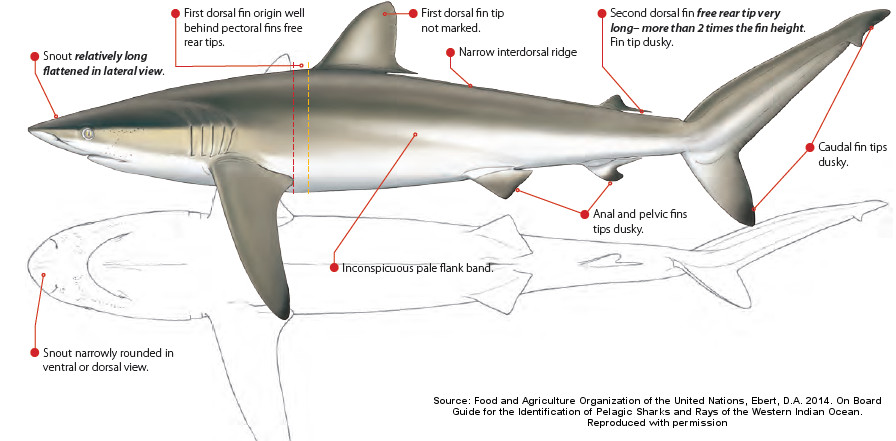
Carcharhinus falciformis (Müller & Henle, 1839), © FAO, Food and Agriculture Organization of the United Nations, Ebert, D.A. 2014. On Board Guide for the Identification of Pelagic Sharks and Rays of the Western Indian Ocean. Reproduced with permission, illustration by Marc Dando , Wildlife Illustrator

Carcharhinus falciformis (Müller & Henle, 1839), © FAO, Food and Agriculture Organization of the United Nations, Ebert, D.A. 2014. On Board Guide for the Identification of Pelagic Sharks and Rays of the Western Indian Ocean. Reproduced with permission, illustration by Marc Dando , Wildlife Illustrator
Common names
 Seidenhai,
Seidenhai,  Cazon,
Cazon,  Cazon de playa,
Cazon de playa,  Cazón-tiburón,
Cazón-tiburón,  Jaqueta,
Jaqueta,  Jaqueton,
Jaqueton,  Tiburon jaqueton,
Tiburon jaqueton,  Tiburón,
Tiburón,  Tiburón lustroso,
Tiburón lustroso,  Tiburón piloto,
Tiburón piloto,  Tiburón sedoso,
Tiburón sedoso,  Tinterero,
Tinterero,  Tollo,
Tollo,  Tollo mantequero,
Tollo mantequero,  Mangeur d"hommes,
Mangeur d"hommes,  Requin soyeux,
Requin soyeux,  Blackspot shark,
Blackspot shark,  Grey whaler shark,
Grey whaler shark,  Olive shark,
Olive shark,  Reef shark,
Reef shark,  Ridgeback shark,
Ridgeback shark,  Shark,
Shark,  Sickle shark,
Sickle shark,  Sickle silk shark,
Sickle silk shark,  Sickle-shaped shark,
Sickle-shaped shark,  Silk shark,
Silk shark,  Silky shark,
Silky shark,  Silky whaler,
Silky whaler,  Cação,
Cação,  Lombo preto,
Lombo preto,  Marracho sedoso,
Marracho sedoso,  Marracho-luzidio,
Marracho-luzidio,  Tubarão-luzidio
Tubarão-luzidio
 Seidenhai,
Seidenhai,  Cazon,
Cazon,  Cazon de playa,
Cazon de playa,  Cazón-tiburón,
Cazón-tiburón,  Jaqueta,
Jaqueta,  Jaqueton,
Jaqueton,  Tiburon jaqueton,
Tiburon jaqueton,  Tiburón,
Tiburón,  Tiburón lustroso,
Tiburón lustroso,  Tiburón piloto,
Tiburón piloto,  Tiburón sedoso,
Tiburón sedoso,  Tinterero,
Tinterero,  Tollo,
Tollo,  Tollo mantequero,
Tollo mantequero,  Mangeur d"hommes,
Mangeur d"hommes,  Requin soyeux,
Requin soyeux,  Blackspot shark,
Blackspot shark,  Grey whaler shark,
Grey whaler shark,  Olive shark,
Olive shark,  Reef shark,
Reef shark,  Ridgeback shark,
Ridgeback shark,  Shark,
Shark,  Sickle shark,
Sickle shark,  Sickle silk shark,
Sickle silk shark,  Sickle-shaped shark,
Sickle-shaped shark,  Silk shark,
Silk shark,  Silky shark,
Silky shark,  Silky whaler,
Silky whaler,  Cação,
Cação,  Lombo preto,
Lombo preto,  Marracho sedoso,
Marracho sedoso,  Marracho-luzidio,
Marracho-luzidio,  Tubarão-luzidio
Tubarão-luzidio
Short Description
Diagnose after Compagno,1984 [517]: Field Marks : A large, dark, slim, oceanic grey shark with moderately long rounded snout, moderately large eyes, oblique-cusped serrated teeth in the upper jaw, upper teeth with basal cusplets or very strong serrations, usually 15/15 rows of anteroposterior teeth, an interdorsal ridge, long narrow pectoral fins, a moderatesized first dorsal with its origin behind the pectoral rear tips, a low second dorsal with a greatly elongated inner margin and rear tips, and no conspicuous markings. Diagnostic Features : A large, fairly slender species (up to about 3.3 m). Snout moderately long and rounded; internarial width 1.2 to 1.6 times in preoral length; eyes circular and moderately large, their length 1.2 to 2.7% of total length; upper labial furrows short and inconspicuous; hyomandibular line of pores just behind mouth corners not conspicuously enlarged; gill slits moderate-sized, the third 2.9 to 3.6% of total length and less than 2/5 of first dorsal base; usually 15/15 rows of anteroposterior teeth in each jaw half but varying from 14 to 16/13 to 17; upper teeth with fairly narrow, strongly serrated, erect to moderately oblique cusps, welldelimited from crown feet, feet with heavy serrations or small cusplets; lower teeth with erect, narrow, smoothedged cusps and transverse roots. A narrow interdorsal ridge present. First dorsal fin moderate-sized and falcate, with narrowly to broadly rounded apex and posterior margin curving ventrally from fin apex; origin of first dorsal fin behind pectoral free rear tips; inner margin of first dorsal long, about half dorsal base or slightly more or less; second dorsal fin very small and low, its height 1.3 to 2.2% of total length, its inner margin long and 1.6 to 3 (usually over 2) times its height; origin of second dorsal over or slightly behind anal origin; pectoral fins large (especially in adults, shorter in young), narrowly falcate, with narrowly rounded or pointed apices, length of anterior margins about 14 to 22% of total length; 199 to 215 total vertebral centra, 98 to 106 precaudal centra. Colour dark grey or grey brown above, sometimes nearly blackish, white below; tips of fins other than first dorsal dusky but not black-tipped; an inconspicuous white band on flank.
Diagnose after Compagno,1984 [517]: Field Marks : A large, dark, slim, oceanic grey shark with moderately long rounded snout, moderately large eyes, oblique-cusped serrated teeth in the upper jaw, upper teeth with basal cusplets or very strong serrations, usually 15/15 rows of anteroposterior teeth, an interdorsal ridge, long narrow pectoral fins, a moderatesized first dorsal with its origin behind the pectoral rear tips, a low second dorsal with a greatly elongated inner margin and rear tips, and no conspicuous markings. Diagnostic Features : A large, fairly slender species (up to about 3.3 m). Snout moderately long and rounded; internarial width 1.2 to 1.6 times in preoral length; eyes circular and moderately large, their length 1.2 to 2.7% of total length; upper labial furrows short and inconspicuous; hyomandibular line of pores just behind mouth corners not conspicuously enlarged; gill slits moderate-sized, the third 2.9 to 3.6% of total length and less than 2/5 of first dorsal base; usually 15/15 rows of anteroposterior teeth in each jaw half but varying from 14 to 16/13 to 17; upper teeth with fairly narrow, strongly serrated, erect to moderately oblique cusps, welldelimited from crown feet, feet with heavy serrations or small cusplets; lower teeth with erect, narrow, smoothedged cusps and transverse roots. A narrow interdorsal ridge present. First dorsal fin moderate-sized and falcate, with narrowly to broadly rounded apex and posterior margin curving ventrally from fin apex; origin of first dorsal fin behind pectoral free rear tips; inner margin of first dorsal long, about half dorsal base or slightly more or less; second dorsal fin very small and low, its height 1.3 to 2.2% of total length, its inner margin long and 1.6 to 3 (usually over 2) times its height; origin of second dorsal over or slightly behind anal origin; pectoral fins large (especially in adults, shorter in young), narrowly falcate, with narrowly rounded or pointed apices, length of anterior margins about 14 to 22% of total length; 199 to 215 total vertebral centra, 98 to 106 precaudal centra. Colour dark grey or grey brown above, sometimes nearly blackish, white below; tips of fins other than first dorsal dusky but not black-tipped; an inconspicuous white band on flank.
Distribution
Circumtropical. Western Atlantic: Massachusetts, USA to southern Brazil, including the Gulf of Mexico and the Caribbean Sea to Uruguay [5839]. Eastern Atlantic: Spain, Madeira to northern Angola; St. Paul"quot;s Rocks [5002]; Cape Verde [20238]. Indo-Pacific: scattered records from the Red Sea and Natal, South Africa [536] to China, New Zealand, and the Caroline, Hawaiian, Phoenix and Line islands. Eastern Pacific: southern Baja California, Mexico to northern Chile. Highly migratory species, Annex I of the 1982 Convention on the Law of the Sea [20076]. First record: 1997: Seto Inland Sea, Japan [12421]; 2012: Ligurian Sea, Northwestern Mediterranean [16151]; 2019: New Ireland Province, Papua New Guinea, western Pacific Ocean [27359]; Source: www.gbif.org
Circumtropical. Western Atlantic: Massachusetts, USA to southern Brazil, including the Gulf of Mexico and the Caribbean Sea to Uruguay [5839]. Eastern Atlantic: Spain, Madeira to northern Angola; St. Paul"quot;s Rocks [5002]; Cape Verde [20238]. Indo-Pacific: scattered records from the Red Sea and Natal, South Africa [536] to China, New Zealand, and the Caroline, Hawaiian, Phoenix and Line islands. Eastern Pacific: southern Baja California, Mexico to northern Chile. Highly migratory species, Annex I of the 1982 Convention on the Law of the Sea [20076]. First record: 1997: Seto Inland Sea, Japan [12421]; 2012: Ligurian Sea, Northwestern Mediterranean [16151]; 2019: New Ireland Province, Papua New Guinea, western Pacific Ocean [27359]; Source: www.gbif.org
Human uses
fisheries: highly commercial; price category: high; price reliability: reliable: based on ex-vessel price for this species
fisheries: highly commercial; price category: high; price reliability: reliable: based on ex-vessel price for this species
Biology
Viviparous, placental [733]. 2-15 pups [1388] (Ref. 37816) born at 57-87 cm TL [544]; 1-16 pups born at 55-72 cm TL. Females appear to breed every year, but there appears to be no reproductive seasonality [2539]. Distinct pairing with embrace [17086]. Often found over deepwater reefs and near insular slopes. When approached by divers, individuals have been seen to perform a "quot;hunch display"quot;, with back arched, head raised and caudal fin lowered, possibly as a defensive threat display. Associated with schools of tuna, causing damage to nets and catches. Referred to as the `net-eater shark"quot; in the tropical eastern Pacific[17641]
Diet: Ecuadorian Pacific [25131]: (data basis: 69 (43 female, 26 males) stomachs analysed, 10 stomach empty, TL 95 cm - 310 cm total length). The authors were able to identify 19 dietary components to the lowest taxon: 12 teleosts and eight cephalopods, as well as the remains of fishes, cephalopods and turtles. Based on the %IRI, teleosts contributed most to the C. falciformis diet. The most important prey were the Scombridae fishes Thunnus albacares (%IRI ¼ 22.4%), Thunnus sp. (12.9%) and Auxis thazard (4.77%). The trophic spectrum of both females and males consisted of teleosts and cephalopods; females also consumed turtles. The most important prey species for males were the cephalopods Ancistrocheirus lesueurii (13.2%) and Vitreledonella richardi (8.8%), while females preferred the fishes T. albacares (29.7%), Thunnus sp. (12.0%) and A. thazard (5.88%)
Viviparous, placental [733]. 2-15 pups [1388] (Ref. 37816) born at 57-87 cm TL [544]; 1-16 pups born at 55-72 cm TL. Females appear to breed every year, but there appears to be no reproductive seasonality [2539]. Distinct pairing with embrace [17086]. Often found over deepwater reefs and near insular slopes. When approached by divers, individuals have been seen to perform a "quot;hunch display"quot;, with back arched, head raised and caudal fin lowered, possibly as a defensive threat display. Associated with schools of tuna, causing damage to nets and catches. Referred to as the `net-eater shark"quot; in the tropical eastern Pacific[17641]
Diet: Ecuadorian Pacific [25131]: (data basis: 69 (43 female, 26 males) stomachs analysed, 10 stomach empty, TL 95 cm - 310 cm total length). The authors were able to identify 19 dietary components to the lowest taxon: 12 teleosts and eight cephalopods, as well as the remains of fishes, cephalopods and turtles. Based on the %IRI, teleosts contributed most to the C. falciformis diet. The most important prey were the Scombridae fishes Thunnus albacares (%IRI ¼ 22.4%), Thunnus sp. (12.9%) and Auxis thazard (4.77%). The trophic spectrum of both females and males consisted of teleosts and cephalopods; females also consumed turtles. The most important prey species for males were the cephalopods Ancistrocheirus lesueurii (13.2%) and Vitreledonella richardi (8.8%), while females preferred the fishes T. albacares (29.7%), Thunnus sp. (12.0%) and A. thazard (5.88%)
Size / Weight / Age
350 cm TL (male/unsexed; [544]); max. published weight: 346.0 kg (Ref. 40637); max. reported age: 25 years [2246]
350 cm TL (male/unsexed; [544]); max. published weight: 346.0 kg (Ref. 40637); max. reported age: 25 years [2246]
Habitat
reef-associated; oceanodromous [17660]; marine; depth range 0 - 4000 m (Ref. 55180), usually 0 - 500 m [1388]
reef-associated; oceanodromous [17660]; marine; depth range 0 - 4000 m (Ref. 55180), usually 0 - 500 m [1388]
Remarks
shark-references Species-ID=749; CITES: (see: Protected Species for more details) Convention on International Trade in Endangered Speciesof Wild Fauna and Flora annex: II; Council Regulation 2017/160 annex: B
shark-references Species-ID=749; CITES: (see: Protected Species for more details) Convention on International Trade in Endangered Speciesof Wild Fauna and Flora annex: II; Council Regulation 2017/160 annex: B
Parasites (arranged by Jürgen Pollerspöck)
Cestoda
Trematoda
Copepoda
Isopoda
Hirudinea
Cestoda
- Dasyrhynchus variouncinatus (Pintner, 1913) [5977] [16112]
- Tentacularia coryphaenae Bosc, 1797 [21816] [32432]
Trematoda
Copepoda
- Alebion carchariae Krøyer, 1863 [19355] [19356]
- Echthrogaleus denticulatus Smith, 1873 [16599]
- Kroyeria carchariaeglauci Hesse, 1878 [17867] [34815]
- Kroyerina cortezensis Deets, 1987 [15948]
- Pandarus cranchii Leach, 1819 [16599] [16583] [16599] [16599] [19355] [19356]
- Pandarus katoi Cressey, 1967 [16599]
- Pandarus smithii Rathbun, 1886 [16583] [16599]
Isopoda
- Gnathia trimaculata Coetzee, Smit, Grutter & Davies, 2009 [21224]
Hirudinea








_menisorrahMUELLER&HENLE,1839valid_as_Carcharhinus_falciformis.jpg)
menisorrahMUELLER&HENLE,1839valid_as_Carcharhinus_falciformis(in_MUELLER&HENLE,1839).jpg)
